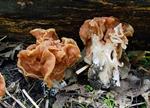
Coll. 2006-04-21
© R. Healy | | | | | |
Gyromitra brunnea Underw., Proc. Indiana Acad. Sci., 1893: 33 (1894).
Basionym Gyromitra brunnea Underw., Proc. Indiana Acad. Sci., 1893: 33 (1894).
Diagnosis A stout, fleshy, stipitate plant, 8-13 cm. high, bearing a broad, much contorted, brown ascoma ; stem 2-5 cm. thick, more or less enlarged and spongy-solid at the base, hollow below, rarely slightly fluted, clear white ; receptacle 5-12 cm. across in the widest direction, the two diameters usually considerably unequal, irregularly lobed and plicate, in places faintly marked into areas by indistinct anastomosing ridges, closely cohering with the stem in various parts, rich chocolate brown or somewhat lighter if much covered with the leaves among which it grows, whitish underneath ; asci 8-spored; spores oval, 28-30 mic. long by about 14 wide, hyaline, somewhat roughened-tuberculate, usually nucleate, the highly refractive nucleus spherical or oval, 11 mic. or if oval 14 by 11 mic. in diameter ; paraphyses slender, enlarged at the apex, faintly septate. In rich woods, mostly in beech leaf mould ; Putnam county. May 1892, 1893 and 1894, first found by Dr. W. V. Brown. The plant is esculent, tender and possesses a fine flavor. Often as many as 8 or 10 plants would be found in one small area but the plant appears to be local and never very abundant. Some single plants would weigh nearly half a pound.
Type Underwood, V.1892 (NY) - lectotypus
Homotypic Helvella underwoodii Seaver, N. Amer. Cup-fungi (Operc.): 254 (1928) ; Neogyromitra brunnea (Underw.) Herter, Rev. Sudamer. Bot., 10 (1): 16 (1951) ; Discina brunnea (Underw.) Raitv., Bot.-alased tõõd, 9: 368 (1970).
MycoBank 146393
Notes
1) H. underwoodii Seaver is a nom. nov. due to H. brunnea J.F. Gmel.
Literature
Abbott S.P., Currah R.S. 1997. The Helvellaceae: systematic revision and occurrence in Northern and Northwestern North America. Mycotaxon, 62: 1-125.
Herter W.G. 1951. Neogyromitra und Maublancomyces, zwei wenig bekannte Morchel-Gattungen. Revista Sudamericana de botanica, 10 (1): 13-24.
Huffman D.M., Tiffany L.H. 2001. Spring morels and false morels of midcontinental U.S. Bioscene, 27 (4): 3-11.
Kuo M. 2005. Morels.
McKnight K.M. 1971. On two species of false Morels (Gyromitra) in Utah. Great Basin Naturalist, 31 (2): 35-47.
McKnight K.M. 1973. Two misunderstood species of Gyromitra (false Morels) in North America. The Michigan Botanist, 12: 147-162.
Methven A.S., Zelski S.E., Miller A.N. 2013. A molecular phylogenetic assessment of the genus Gyromitra in North America. Mycologia, 105 (5): 1306-1314.
Raitviir A. 1970. Once more on Neogyromitra caroliniana. Botaanika-alased tõõd, 9: 364-371.
Seaver F.J. 1928. The North American Cup-Fungi (Operculates).
Svrček M., Moravec J. 1972. O druhu Helvella fastigiata Krombholz. Česká Mykologie, 26 (1): 1-8.
Underwood L.M. 1893. List of Cryptogams at present known to inhabit the State of Indiana. Proceedings of the Indiana Academy of Science, 1893: 30-67.
Van Vooren N., Moreau P.A. 2009. Essai taxinomique sur le genre Gyromitra Fr. sensu lato (Pezizales). 4. Le genre Gyromitra Fr., sous-genre Caroliniana. Ascomycete.org, 1 (2): 15-20.
Weber N.S. 1995. A Morel hunter’s companion.
Classification: Discinaceae, Gyromitra
Created on 30/05/2015.
Updated on 02/08/2023.
